« Getting started with dry suits | Main | The importance of picking the right dive suit »
March 24, 2009
Wreck diving off San Diego, California
Diving the Yukon
No, not the Yukon up north but the HMCS Yukon, a Canadian McKenzie Class destroyer that now sits in 105 feet of frigid water a couple of miles off the coast of San Diego. As far as wrecks go, the Yukon is a big and imposing one. It’s 366 feet long, displaces almost 3,000 tons, and has some menacing looking guns. 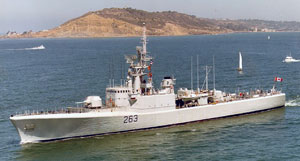 The ship was launched in 1961 and sunk in July of 2000 to form an artificial reef. Unlike ships that sink all by themselves, the Yukon was helped along, after having been thoroughly prepped for scuba diving adventures by cutting a large number of holes into its sides and decks. The actual sinking of the Yukon was supposed to be an orderly event witnessed by thousands of boats. Maps had been drawn, cutouts were all neatly marked, and there were even laminated “You Are Here†orientation maps in many strategic points inside the vessel. (see article "Map the Yukon" in Geospatial Solutions)
The ship was launched in 1961 and sunk in July of 2000 to form an artificial reef. Unlike ships that sink all by themselves, the Yukon was helped along, after having been thoroughly prepped for scuba diving adventures by cutting a large number of holes into its sides and decks. The actual sinking of the Yukon was supposed to be an orderly event witnessed by thousands of boats. Maps had been drawn, cutouts were all neatly marked, and there were even laminated “You Are Here†orientation maps in many strategic points inside the vessel. (see article "Map the Yukon" in Geospatial Solutions)
The Yukon, however, had other plans. Rougher than anticipated seas made the ship take on water through the cut-outs in its side, and so she simply sank, ahead of time. She also did not neatly settle on the sandy bottom, but rolled over and came to rest sideways. Some of the planned cutouts remained unmade as the shape charges never went off, and the nice, neat map, while still technically accurate (except for the cutouts), isn’t of much use with the ship now laying on its side. Those who want to see how the Yukon rests at a depth of 105 feet should get Franko’s HMCS Yukon Deck Plan. It shows an exploded view of all six decks as well as floor plans and all the current cutouts.
I had been invited to dive the Yukon early on in my scuba career, but at that time I had not been ready yet. Now I felt I was, and so I had signed up for three days of wreck diving with our friends at Fisheye Scuba. We drove the 500 miles or so from Folsom to San Diego’s Mission Bay area and stayed at the Dana Hotel that was right across the street from our dive charter, Waterhorse. The Dana Hotel is also very close to SeaWorld San Diego, but, in all fairness, why go to an expensive seaworld theme park when a mile away you can see and experience the real thing?
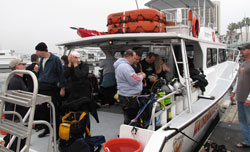 About 16 people had signed up for the trip, some doing their PADI wreck diving certification dives and others, like us, just doing the diving itself. I had no idea what to expect. This was going to be my first time in the waters of the Pacific. Kate of Fisheye Scuba had said the water temperature was going to be in the high 50s on the surface and 52 or so at the bottom. Half the divers were going to wear drysuits and the others wetsuits. Not having a drysuit, I brought along my 7mm Scubapro Form wetsuit. And hood, and gloves. And not one but two pairs of Shammyz to keep warm, one of them with the special windbreaker that zippers on the outside.
About 16 people had signed up for the trip, some doing their PADI wreck diving certification dives and others, like us, just doing the diving itself. I had no idea what to expect. This was going to be my first time in the waters of the Pacific. Kate of Fisheye Scuba had said the water temperature was going to be in the high 50s on the surface and 52 or so at the bottom. Half the divers were going to wear drysuits and the others wetsuits. Not having a drysuit, I brought along my 7mm Scubapro Form wetsuit. And hood, and gloves. And not one but two pairs of Shammyz to keep warm, one of them with the special windbreaker that zippers on the outside.
Set the alarm for 6am and made it to the dock by 7:30am where there were already a number of folks unloading trucks, donning gear, signing papers and using a big dolly to get tanks and gear to the dive boat. Half an hour or so we were all on the boat, which was a cozy affair with a head, a nice cabin where the captain had set up snacks, fruit and beverages, and even a hot shower. The boat had its own compressor so they didn't even have to take the tanks off the boat to fill them. Carol had brought her two Nitrox steel-80 tanks (US$12 per fill as they had to take those off the boat); I used the rental aluminum 80s that came with the trip.
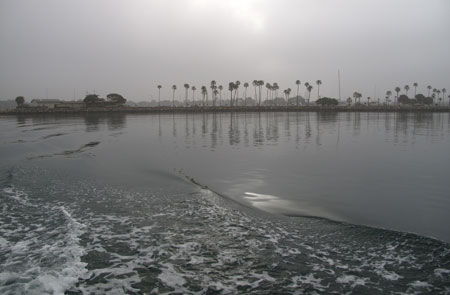
The weather was typical San Diego, that is all foggy so that it looked like it was a gray, overcast day. It’s just fog, of course, but it feels coldish and dreary anyway. The fog usually burns off around 11am or so, but not always, and sometimes it goes away and then comes back. Kate gathered her wreck class group for a briefing, and then the captain did a dive briefing of his own. The first dive was the big one, the Yukon. She’s a big one, we learned, just look at the bow and stern buoys (they were far apart for sure). Viz isn’t very good, like 20 feet or so. Look out for the surge as it can suck you right into an opening and spit you back out. Other than that, go down the line, do the dive, and come back up. It’s actually refreshing that it’s all so straightforward in something so potentially dangerous.
After having checked all my stuff and gear at least five times, including the Canon G10 in its underwater housing, the Scubapro dive knife I had strapped onto my right arm, and the little dive light, I did a giant stride into the darkish sea. You always heat up quite a bit in a 7mm wetsuit, and so the 56 degree water actually felt quite refreshing. Carol and I had vowed to stay close together and so I waited for her before I descended. Turns out she didn’t have enough weight and had to add another two pounds. I had guessed 24 pounds for me, and that ended up being just right.
Going down, the water was all green. I had a bit of a sinus pressure ache in my forehead at around 15 feet. So I stopped rather than force it and end up with a big nosebleed as I had in Honduras. The ache subsided and I resumed the descent. It quickly got colder and darker, and two minutes later giant shapes came into view, the Yukon. If you are not a diver you may think it must be quite interesting to simply float and look down onto a sunken ship. It is very interesting, but ship wrecks hardly ever sit in crystal clear water so you can really see them. Instead, they may be so broken that you hardly recognize them. It’s amazing what the sea can do to a ship in just a few years. Or it is so dark and murky that you can only see what’s practically in front of your nose. Now imagine a 366 foot vessel lying on its side, and you’re looking at it essentially in the dark and with a visibility of no more than 15 feet or so.
What that means is that things come into view and then disappear again. You don’t quite know what they are or where you are. I had thought the map would help me orient myself, but it was much too dark and murky for that. I was so enthralled with the adventure of it all that I actually completely forgot that the ship was sideways. All I could concentrate on was the encroaching cold, checking my gauges to make sure I didn’t get too deep or run out of bottom time, and, most importantly, not to lose Carol. We both had cameras and I was determined to at least take a few shots.
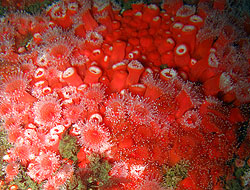 I was stunned at how much aquatic life had already taken hold on the ship. Anyone expecting a gleaming high-tech destroyer to still look pretty much the same after nine years underwater, not so. There’s a thick crust of coral, anemones and other sealife, with thousands of large and totally white anemones giving the ship a surreal look. Some kelp was floating around, too, showing just how strong the surge was. I tried to take pictures, but between the unfamiliar layout of the button controls of a new camera and the eerie surroundings, I didn’t get much. When the flash did go off, I saw that the coral surrounding the anemones was bright red.
I was stunned at how much aquatic life had already taken hold on the ship. Anyone expecting a gleaming high-tech destroyer to still look pretty much the same after nine years underwater, not so. There’s a thick crust of coral, anemones and other sealife, with thousands of large and totally white anemones giving the ship a surreal look. Some kelp was floating around, too, showing just how strong the surge was. I tried to take pictures, but between the unfamiliar layout of the button controls of a new camera and the eerie surroundings, I didn’t get much. When the flash did go off, I saw that the coral surrounding the anemones was bright red.
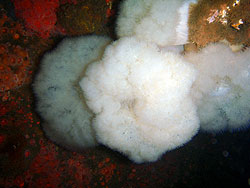 Every dive is different. Even though the surroundings were quite intimidating, I felt calm and free of anxiety. I seemed to spend equal time taking in whatever sight I could of the massive wreck, making sure I did not lose my buddy, trying to take pictures, and checking depth and air. I did not come close to penetrating the wreck, or even come close to one of the openings. I really wanted to see the big guns but there was no time to do any exploring. While the wreck laid in semi-darkness where the lights came in handy, I could see light above and quite a few fish, whole schools. There wasn’t, though, anywhere near the variety I saw in Honduras. I looked at the dark shapes of encrusted metal and felt that anyone who got lost in there would hardly have a chance to come out alive or be found and rescued in time.
Every dive is different. Even though the surroundings were quite intimidating, I felt calm and free of anxiety. I seemed to spend equal time taking in whatever sight I could of the massive wreck, making sure I did not lose my buddy, trying to take pictures, and checking depth and air. I did not come close to penetrating the wreck, or even come close to one of the openings. I really wanted to see the big guns but there was no time to do any exploring. While the wreck laid in semi-darkness where the lights came in handy, I could see light above and quite a few fish, whole schools. There wasn’t, though, anywhere near the variety I saw in Honduras. I looked at the dark shapes of encrusted metal and felt that anyone who got lost in there would hardly have a chance to come out alive or be found and rescued in time.
Time went very quickly. It was a bit hard to clearly see the data on my Uwatec Smart-Z wrist-mounted dive computer in the near darkness and so I made extra-sure to stay on top of remaining air. After 25 minutes at the wreck, at depths between 65 and 82 feet and at a constant temperature of 51 degrees, I was down to 850 psi and 6 minutes of nitrogen time. Though we had not moved around much, I had no idea where the descent line was and motioned to Carol that it was time for me to go up. Carol did know (it was only a few feet away) and we went up, doing a four minute safety stop at 15 feet. Using less air and being on Nitrox, she still had a good third left, and nitrogen time had never been an issue.
Back up on the boat I felt both elated and quite cold. Even a bowl of steaming hot minestrone soup didn’t eliminate all the shivering and so, after two test divers reported poor visibility at the second dive site (the cutter Ruby E), I decided to call it a day. I had dived the Yukon, and that felt really good.
No two wrecks are the same, and every wreck dive is different. Temperature and visibility can make a huge difference. A wreck in good light and clear water is totally different from a wreck in the semi-dark at almost no visibility. I am glad I did this dive. I enjoyed myself and I did not feel anxious. I did well. But I realized once again that this is not a harmless sport. The margin for error is very little.
Diving the Ruby E
After the very cold, murky dive to the Yukon I wondered what Day Two of our wreck diving trip would bring. I’d been asking myself why the dive boats go out early in the morning when just about every day in San Diego seems gray and foggy until about the time the dive boats return. I’ve heard a number of explanations, from the sea being calmer in the morning, to dive boat captains wanting to go home early, to the tide and such. I still don’t know what the actual reason is. It’s definitely no fun to get up early for a few hours of dreary fog when one knows the weather will most likely clear up around 11AM or so.
Anyway, I really didn’t feel too hot as we made our way across the street to the dock. Everything was damp and clammy and I racked my brain trying to figure out the best way to stay reasonably warm and dry through the process. At 8:15AM we took off onto the grayish sea under a grayish sky. First stop was a lobster trap rescue operation. Seems one of those crude, yet effective lobster trap cages made of chicken wire and rebar had gotten stuck. Ryan of Fisheye Scuba dove into the frigid waters. After a few minutes he re-emerged, mission accomplished. The captain of the tiny fishing boat was happy.
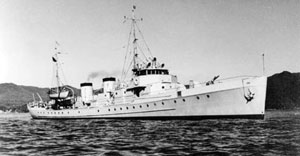 On we went to our first destination, which was the wreck of the 165-foot Coast Guard Cutter Ruby E originally designed to enforce prohibition and launched in 1934. The vessel then had a checkered history (including submarine control, fishing, salvage and even a bit of drug smuggling, and she ran under various names. The Ruby E is a much smaller ship than the massive Yukon and had been sitting on the bottom since her sinking in 1989, 11 years longer than the Yukon.
On we went to our first destination, which was the wreck of the 165-foot Coast Guard Cutter Ruby E originally designed to enforce prohibition and launched in 1934. The vessel then had a checkered history (including submarine control, fishing, salvage and even a bit of drug smuggling, and she ran under various names. The Ruby E is a much smaller ship than the massive Yukon and had been sitting on the bottom since her sinking in 1989, 11 years longer than the Yukon.
We geared up, with Carol donning the Liquid Image camera mask. The camera mask was invented by a camera located in the Sacramento area and combines a 5-megapixel CMOS camera that can also do video with a regular dive mask. This sounds somewhat gimmicky, and looks it, too, but the thing seemed well designed and we’d actually had had dinner with Liquid Image executives a few days prior to the trip. They’d explained the device, how it came about, and what it could do. We had offered to take it along for an underwater test. And while this version of the camera mask only had a 33-foot depth rating, we planned to take it down to the Ruby E, which sits in about 85 feet of water.
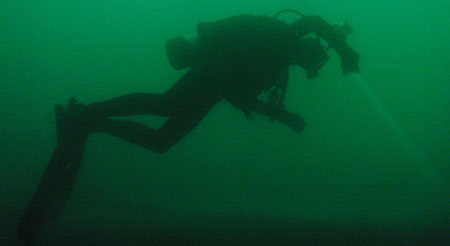
The water was green as we went down the descent line and it got dark quickly. By the time we reached the sandy bottom we could barely see the bow of the cutter. It was cold, barely 50 degrees, the visibility was poor (perhaps 15 feet), and there was a strong surge back and forth. Without being able to see much, exploring a wreck becomes a matter of slowly examining what appears in front of your eyes. 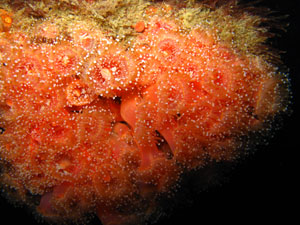 The Ruby E was reasonably intact, but all surfaces were totally overgrown with a dense cover of small strawberry anemones and similar critters. There were none of the giant white anemones here as we'd found on the Yukon. We saw a good number of starfish that come in a wide variety of shapes, sizes and colors. Carol, aware that the camera mask was recording, kept moving so that her exhaust bubbles did not obscure the recording and also made an effort to keep her head still, which with the data mask meant the same as holding the camera steady. The mask apparently worked as it wasn’t fogged up and she did not seem to experience any problems.
The Ruby E was reasonably intact, but all surfaces were totally overgrown with a dense cover of small strawberry anemones and similar critters. There were none of the giant white anemones here as we'd found on the Yukon. We saw a good number of starfish that come in a wide variety of shapes, sizes and colors. Carol, aware that the camera mask was recording, kept moving so that her exhaust bubbles did not obscure the recording and also made an effort to keep her head still, which with the data mask meant the same as holding the camera steady. The mask apparently worked as it wasn’t fogged up and she did not seem to experience any problems.
I tried to get some good shots with my Canon G10, but it was mostly a futile effort. Between the surge and the cold, things just weren’t very pleasant. If a bit of cold and dark does not seem like a big deal, consider that this is a cold one cannot escape from. Down there, you cannot duck into a doorway to get reprieve from an icy blast or wind. You also cannot button your coat or pull up the zipper or a hood. What you’re wearing is all you got, and it cannot be changed. The dark and surge makes it worse. Add to that an unfamiliar place that remains largely hidden from sight, and things can get somewhat stressful in a hurry. I never felt truly anxious, but also did not enjoy myself. It was just too cold. Eventually it got so that I began to shiver. It was time to get back up anyway and, as usual, Carol almost instantly found the descent line (how does she do that?). At the 15-foot stop the water was back to 57 and, comparatively, felt like bath water. I was glad.
Back on the boat I wasn’t sure if I’d be able to do a second dive. Even sitting inside the cabin I was shivering, and even hot soup and a big cup of hot chocolate did little to warm me up. I felt annoyed by that as I am not usually that susceptible to cold. I really did not want to miss another dive, and so I willed myself to stop shivering and get ready to brace the cold water again.
In the meantime, Kate’s wreck diving students compared notes and had a critique, though I am not sure how much people actually heard over the noise of the engines. I don’t think much wreck penetration was done, but they got to practice site surveys, handling their reels, and other wreck diving techniques.
Diving kelp
The second dive was in a kelp field. I had read a lot about the kelp forest off the coast of California and didn’t quite know what to make of it. It sounded quite intimidating and invoked unpleasant memories of fighting off sea weed and assorted algae when I was a child. Whatever I’d read of the underwater kelp forests was invariably positive, though I’d also come across references of people getting caught in kelp and having to use knifes or requiring assistance to extricate themselves. Kelp, apparently, was also where a lot of fish and other critters hung out, and there were many accounts of divers suddenly finding themselves with a big fish or a sea otter or some other creature.
When we arrived at our destination, it really didn’t look very pleasant. A lot of what I used to consider "sea weed" was bobbing on the surface, making the water look murky and somehow not clear or clean. In his briefing, the captain described a ledge and rocky area underneath us and said we might expect to see some larger animals. He said stay below the surface to keep from getting entangled in the kelp once we came back up, and, should we get stuck, to simply drop down rather than fight the kelp. I didn’t quite know what to make of that, but in I went.
The water wasn’t much clearer here, but at least we didn’t descend into darkish depths. Instead, as soon as I dropped below the surface I saw the kelp forest, which turned out to be a magical world of gently swaying leafy plants vertically in the water. Far from being mere “sea weed,†kelp is intricate, beautiful, and unlike anything that grows on dry land. It isn’t just a stalk and leaves ether; instead, the plant makes a multitude of different tendrils, spirally growths, leaf-like structures held up by battalions of bulb-like floaters, and it all sways together in a gentle concert of fluid motion. It is captivating and Carol took numerous pictures.
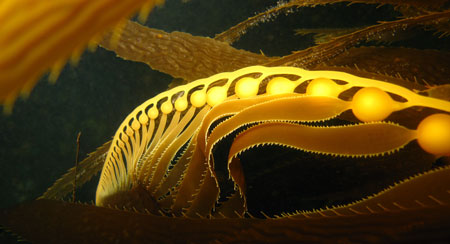
We quickly reached bottom that looked much like the coral reefs of the Caribbean, only without the variety of fish and colors, or the clarity of the water. Instead, there was strong surge back and forth. Examining the bottom we found a lot of urchins and many starfish, a Garibaldi or two, and some other critters. I had read a book on urchin fishing in California, which had been a lucrative trade and industry in the 1980s and 90s when the Japanese bought up whatever enterprising professional divers could bring up. I somehow thought the urchins were just sitting on the ocean floor, but the vast majority is actually burrowed into the surface in roundish cubbies. I don’t know if they ever come out or simply stay there. Some are quite large, much bigger than I thought they get. Some seemed the size of basketballs.
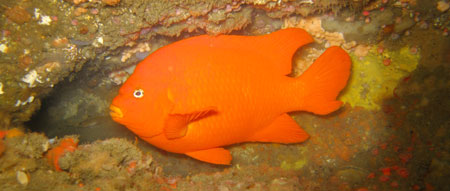
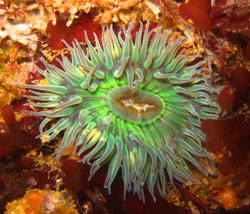 We swam between rock outcroppings that rose to within 25 feet of the surface, then dropped down vertically to lower ground in the mid to high 40s. The water was colder and less clear on this side, but it was still fascinating to swim between the kelp plants. They were not dense enough to get lost in them or having to fight one’s way through by any means. There was plenty of room. I was getting cold again and began my ascent after 35 minutes or so. I’d found the boat’s anchor line and so had a clear shot straight up. Carol followed, taking many beautiful close-up and macro pictures of the kelp plants and some of the amazingly colorful critters that live on and between it. Some look downright psychedelic and when you look at the pictures later, it's hard to believe that something that beautiful is in the cold and dark water.
We swam between rock outcroppings that rose to within 25 feet of the surface, then dropped down vertically to lower ground in the mid to high 40s. The water was colder and less clear on this side, but it was still fascinating to swim between the kelp plants. They were not dense enough to get lost in them or having to fight one’s way through by any means. There was plenty of room. I was getting cold again and began my ascent after 35 minutes or so. I’d found the boat’s anchor line and so had a clear shot straight up. Carol followed, taking many beautiful close-up and macro pictures of the kelp plants and some of the amazingly colorful critters that live on and between it. Some look downright psychedelic and when you look at the pictures later, it's hard to believe that something that beautiful is in the cold and dark water.
Me, I was glad I’d overcome the cold and made the dive.
Another dive to the Yukon
Our last day started like the first two, with a gray sky and a chill in the air. In addition to getting ready for diving, we also had to pack up our stuff, put it in the car, and check out. Logistics can get a bit overwhelming at times.
This time I decided to wear my Akona dive skin underneath the 7mm wetsuit and see if that helped me fend off the penetrating cold. The wetsuit certainly goes on easier when you wear a dive skin, but when you have to go to the bathroom, it’s yet another item to somehow get out of the way.
The first dive was a second descent to the Yukon. That was certainly alright with me, but I wondered whether a repeat dive was due to the wreck diving class or whether there were no other suitable wrecks. This was, after all, “wreck alley.†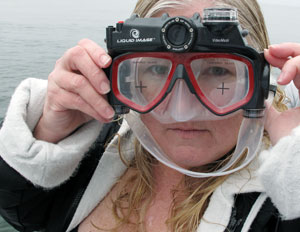 On this dive we were going to be testing the Liquid Image Camera Mask again, recording and documenting the entire dive. The water was 57 on the surface, but quickly got colder as we descended down the line into semi-darkness. This time our mooring line got us to the center of the Yukon. The world was all green down there and once again, it was difficult to make out anything but darkish shapes at the very edge of the 15-foot or so visibility range we now found ourselves in. They were parts of the ship, but it was mostly impossible to figure out which parts.
On this dive we were going to be testing the Liquid Image Camera Mask again, recording and documenting the entire dive. The water was 57 on the surface, but quickly got colder as we descended down the line into semi-darkness. This time our mooring line got us to the center of the Yukon. The world was all green down there and once again, it was difficult to make out anything but darkish shapes at the very edge of the 15-foot or so visibility range we now found ourselves in. They were parts of the ship, but it was mostly impossible to figure out which parts.
The top of the ship had a lush growth of kelp or weeds on it, and they were moving with the surge that washed over the ship. I descended down what must have been the deck surface in front of the bridge and found the water to be both calmer and darker. I was at 91 feet in 51-degree water; trying to get my bearings, trying not to get lost, staying calm, and figuring out where I was. Since it was so dark and murky, everyone stayed reasonably close together and so I was watching dive lights of my fellow divers as they shone into some of the cutouts, tied off lines, handled reels, and slowly entered the wreck.
Though I was very careful I temporarily lost sight of Carol, white fins and all, and felt a sense of frustration over that as I wanted to experience and explore for the precious minutes down on the wreck rather than spend the time searching for my dive buddy. At this depth and under these conditions I really didn’t want to dive solo, and I also didn’t just want to join another group. Fortunately, Carol found me after a few minutes.
My total time down by the Yukon was 22 minutes, from the time I arrived at the bottom of the descent line to the time Carol and I began our ascent. It didn’t feel that long, but it also wasn’t long enough to do, or even start, anything meaningful. So the dive was mostly looking at this and that, and simply holding it together at this murky depth. I took some pictures of the white anemone, marveled at just how colorful the growth was. The ever-present strawberry anemone, whose scientific name is corynactis californica, covered large areas of the wreck, bursting in bright red whenever touched by a flashlight or dive light. These are really neither anemones nor coral, but somewhere in between. Individual strawberry anemone don’t grow larger than an inch, but they can cover something as large as the wreck of a destroyer.
Again, I cannot overemphasize the difference between 90 feet in warm, clear, bright Caribbean waters and 90 feet at 50 degrees, poor visibility and near dark. It’s a bit like the difference between cruising along in sunny daylight, enjoying yourself, and driving at night and in the rain or snow and having to really concentrate on what you’re doing.
The ascent means a progressively lighter shade of green, and also noticeably warmer water. Warmer, of course, is relative as it is only the difference between 51 and 57 degrees. I swam to the dive boat, took off my fins, climbed up onto the deck and plopped down, exhausted, but happy. It’d been a good dive, and it felt like a monumental thing.
Carol thought the camera mask had given up its ghost as it looked like the lens had condensation or water inside. Later I found that the mask had recorded the entire 40-minute dive in one giant 2GB file.
After the dive I was unable to warm up and couldn’t stop shivering no matter what I tried. So I decided to skip the second dive, another kelp dive, and watch the goings-on on the dive, the San Diego coast, and the bubbles of my fellow divers. The bubbles hardly moved. When you’re down there you think you’re moving around quite a bit, but the bubbles tell otherwise, at least when there is no current to carry you away.
Posted by conradb212 at March 24, 2009 10:05 PM








